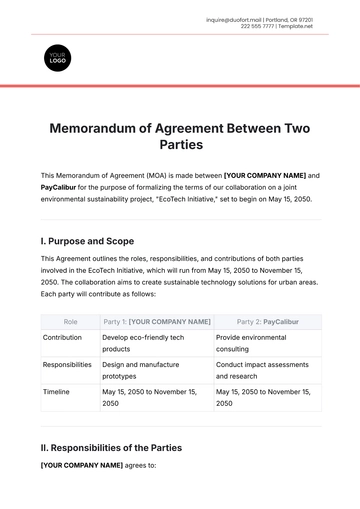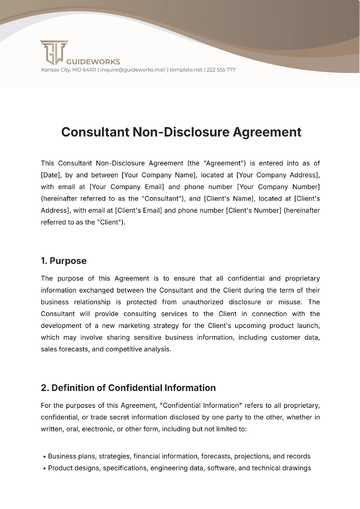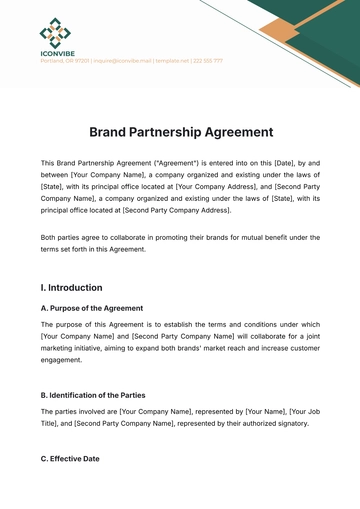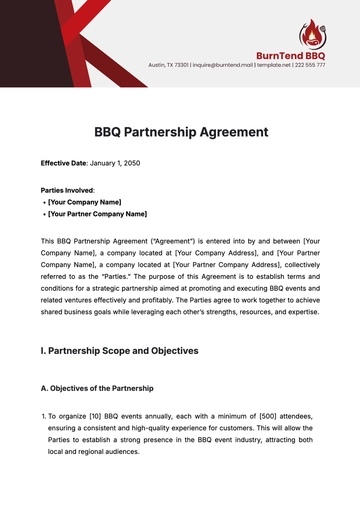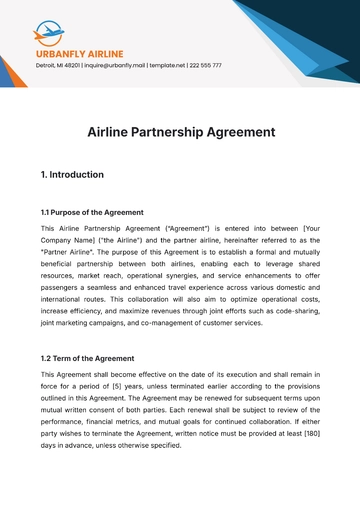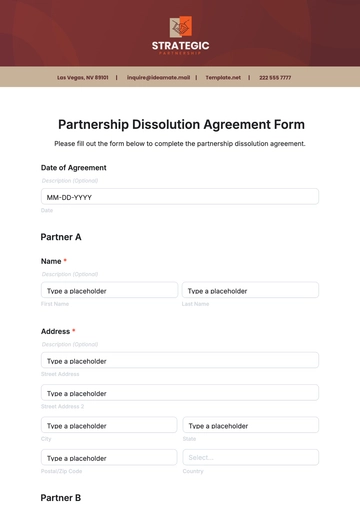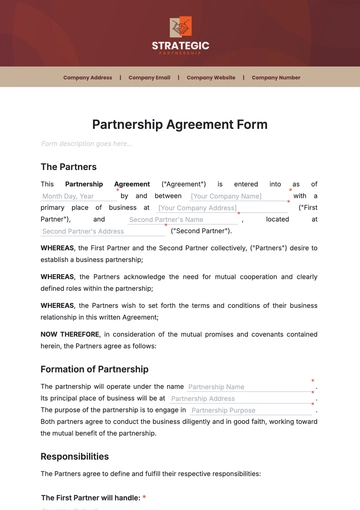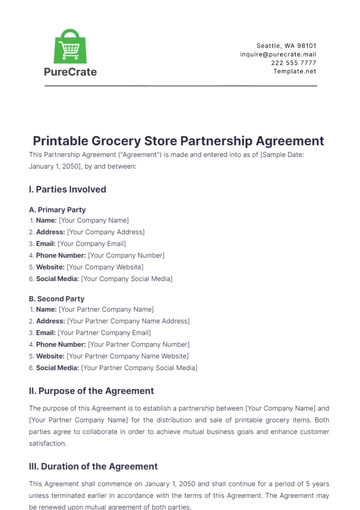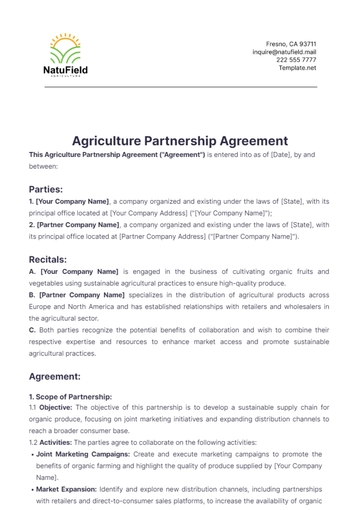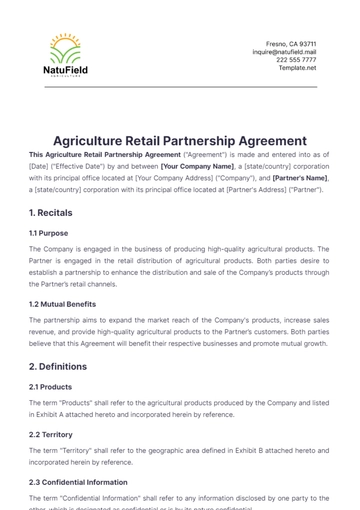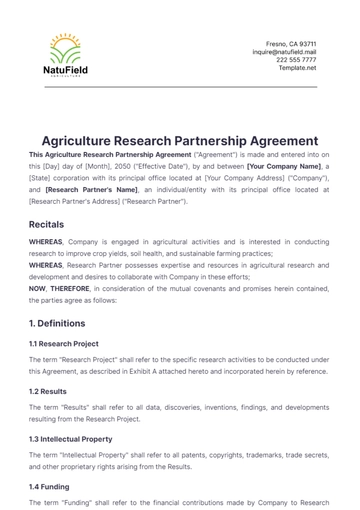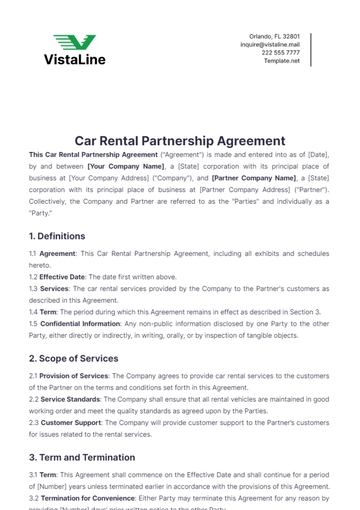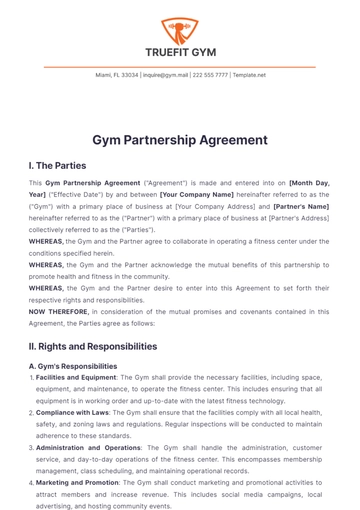Free Small Business Partnership Agreement

This Small Business Partnership Agreement ("Agreement") is entered into as of the below-signed date featured at the end of the document, by and between [Your Company Name], located at [Your Company Address], with a company number of [Your Company Number], and represented by [Your Name], who can be contacted at [Your Email], (hereinafter referred to as "Party A"), and [Party B Company Name], located at [Party B Company Address], with a company number of [Party B Company Number], and represented by [Party B Name], who can be contacted at [Party B Email], herein referred to as "Party B".
1. Purpose of Agreement
This Agreement outlines the business partnership between Party A and Party B, formalizing their commitments and clearly defining their roles, responsibilities, and rights. It establishes each party's stake in the business, sets the groundwork for fair decision-making, and clarifies obligations. By fostering trust and accountability, this Agreement strengthens the partnership and sets the stage for a prosperous business collaboration.
2. Terms of Partnership
Upon signing this Agreement, the Parties begin a partnership promoting joint ventures. Both pledge to contribute resources like money, property, or services, forming a mutual commitment foundational to collaboration. The agreed terms guide the partnership's conduct and are essential for transparency and achieving shared goals. The Parties must contribute resources at the beginning, according to the Agreement, allowing fair distribution and business growth. This Agreement fosters a cooperative, innovative environment promoting mutual growth through adherence to the terms, effective communication, and respect.
3. Distribution of Profits and Losses
The profit and loss distribution will strictly adhere to predetermined ownership percentages of all parties. No changes can be made without written consent, ensuring transparency and trust. This promotes teamwork, mutual understanding, and collective decision-making in business management.
3.1 Proportional Sharing: Profits and losses in the business will be distributed under each party's ownership percentage.
3.2 Written Agreement Requirement: Any alterations to the distribution of profits and losses necessitate a documented agreement signed by all involved parties.
3.3 Ownership-Based Allocation: Changes to profit and loss distribution must be collectively consented to by both parties involved in the business.
4. Decision Making and Management
In business partnerships, fair participation in decisions and management is crucial for trust and collaboration. Acknowledging equal rights and roles fosters effective teamwork and transparency. Striving for unanimous agreement on big decisions shields the partnership from unilateral actions, promoting consensus and stakeholder involvement. This cultivates a mutually beneficial partnership for tackling challenges, stimulating respect and cooperation, and enabling long-term success.
5. Compensation and Benefits
Any partnership-derived compensation or benefits, including but not limited to salaries and bonuses, will be divided as per this Agreement's terms. Any changes to this agreement require mutual consent of both parties and must be written down to create a clear amendment record.
5.1 Agreed Distribution Method: Compensation and benefits stemming from the partnership, such as salaries and bonuses, will be divided according to the terms outlined in this Agreement. Alterations to this distribution scheme require written consent from both Party A and Party B.
5.2 Joint Decision Making: Any modifications to the agreed compensation and benefits structure necessitate mutual agreement between Party A and Party B, formalized in written form. This ensures transparency and fairness in the distribution process.
5.3 Documented Consent: Both parties must provide written consent for any adjustments to the compensation and benefits arrangement outlined in the Agreement, maintaining clear communication and accountability throughout the partnership.
6. Confidentiality and Non-Disclosure
Both parties concur that all shared sensitive or proprietary information is to be held confidential during and after their partnership. This includes business plans, financial data, client lists, and trade secrets vital to the business operation and growth. Both consider utmost confidentiality paramount.
6.1 Scope of Confidentiality: The agreement encompasses all proprietary information exchanged between the parties, ensuring the protection of sensitive data such as business strategies and financial records from unauthorized disclosure.
6.2 Duration of Confidentiality: The obligation to maintain confidentiality extends beyond the termination of the partnership, safeguarding trade secrets and client lists against any potential misuse or unauthorized dissemination.
6.3 Exceptions to Confidentiality: Limited exceptions may apply, such as disclosures required by law or court order, but otherwise, both parties are committed to upholding the strict confidentiality of the shared information.
6.4 Handling of Confidential Information: Both parties agree to exercise reasonable care in handling confidential materials, and implementing measures to prevent unauthorized access or disclosure to third parties.
6.5 Enforcement of Non-Disclosure: Violation of the confidentiality agreement may result in legal consequences, including injunctions and financial damages, emphasizing the seriousness of maintaining the confidentiality of shared information.
7. Termination Conditions
This agreement can be terminated by either party, provided they issue a written notice detailing the reasons for such termination. Following the conclusion of this agreement due to termination, it is mandatory for all remaining financial obligations to be satisfied and all business matters to be completely finalized. These requirements must be fulfilled under the stipulations outlined in Section 7.
7.1 Termination Clause: This section delineates the conditions under which either party can end the agreement, emphasizing the necessity of providing written notice and specifying reasons for termination. It highlights the importance of cooperation between both parties in concluding partnership affairs systematically.
7.2 Debt Settlement: In case of termination, it is stipulated that any outstanding debts or obligations must be resolved before dissolution, ensuring financial clarity and responsibility post-termination.
7.3 Legal Governance: The terms and conditions of termination are to be governed by the laws outlined in Section 7 of the Agreement, providing a legal framework for the termination process and ensuring adherence to applicable regulations.
8. Dispute Resolution
Dispute resolution is key to maintaining smooth operations and relationships in any agreement. The initial step should be good faith negotiations, aiming to understand both parties' views and find common ground. If this fails, mediation with a pre-agreed mediator can help parties to communicate issues and seek a shared solution with neutral help. In case mediation is unsuccessful, arbitration, as per the Arbitration Association, offers a final, binding resolution mechanism. By accepting the arbitrator's decision, all parties agree to uphold the agreement and progress positively.
9. Governing Law
This Agreement shall be governed by and construed under the laws of the [State] without regard to its conflict of laws principles. Any legal action arising from or relating to this Agreement shall be brought exclusively in the court.
IN WITNESS WHEREOF, the Parties hereto have executed this Agreement as of [Effective Date].

[PARTY A'S NAME]
[DATE SIGNED]

[PARTY B'S NAME]
[DATE SIGNED]
- 100% Customizable, free editor
- Access 1 Million+ Templates, photo’s & graphics
- Download or share as a template
- Click and replace photos, graphics, text, backgrounds
- Resize, crop, AI write & more
- Access advanced editor
Enhance and Discover the Small Business Partnership Agreement Template by Template.net. Crafted with small businesses in mind, this editable and customizable document ensures clarity and protection for all parties involved. Seamlessly adjust clauses and terms with ease using our Ai Editor Tool. Enjoy the uniqueness of this simplified partnership agreement today.
You may also like
- Lease Agreement
- Non Compete Agreement
- Rental Agreement
- Prenuptial Agreement
- Non Disclosure Agreement
- Operating Agreement
- Hold Harmless Agreement
- LLC Operating Agreement
- Arbitration Agreement
- Purchase Agreement
- Residential Lease Agreement
- Executive Agreement
- Confidentiality Agreement
- Contractor Agreement
- Partnership Agreement
- Postnuptial Agreement
- Collective Bargaining Agreement
- Loan Agreement
- Roommate Agreement
- Commercial Lease Agreement
- Separation Agreement
- Cohabitation Agreement
- Room Rental Agreement
- Child Custody Agreement
- Employee Agreement
- License Agreements
- Settlement Agreement
- Joint Venture Agreement
- Indemnity Agreement
- Subordination Agreement
- Sales Agreement
- Agreements Between Two Parties
- Business Agreement
- Real Estate Agreement
- HR Agreement
- Service Agreement
- Property Agreement
- Agreement Letter
- Restaurant Agreement
- Construction Agreement
- Finance Agreement
- Marketing Agreement
- Payment Agreement
- Investment Agreement
- Management Agreement
- Nonprofit Agreement
- Software Agreement
- Startup Agreement
- Agency Agreement
- Copyright Agreement
- Collaboration Agreement
- Reseller Agreement
- Car Rental Agreement
- Cleaning Services Agreement
- Consultant Agreement
- Deed Agreement
- Car Agreement
- Equipment Agreement
- Shares Agreement
- Data Sharing Agreement
- Advertising Agreement
- School Agreement
- Franchise Agreement
- Event Agreement
- Travel Agency Agreement
- Vehicle Agreement
- Board Resolution Agreement
- Land Agreement
- Binding Agreement
- Tenancy Agreement
- Exclusive Agreement
- Development Agreement
- Assignment Agreement
- Design Agreement
- Equity Agreement
- Mortgage Agreement
- Purchase and Sale Agreement
- Shareholder Agreement
- Vendor Agreement
- Royalty Agreement
- Vehicle Lease Agreement
- Hotel Agreement
- Tenant Agreement
- Artist Agreement
- Commission Agreement
- Consignment Agreement
- Debt Agreement
- Recruitment Agreement
- Training Agreement
- Transfer Agreement
- Apprenticeship Agreement
- IT and Software Agreement
- Referral Agreement
- Resolution Agreement
- Waiver Agreement
- Consent Agreement
- Partner Agreement
- Social Media Agreement
- Customer Agreement
- Credit Agreement
- Supply Agreement
- Agent Agreement
- Brand Agreement
- Law Firm Agreement
- Maintenance Agreement
- Mutual Agreement
- Retail Agreement
- Deposit Agreement
- Land Purchase Agreement
- Nursing Home Agreement
- Supplier Agreement
- Buy Sell Agreement
- Child Support Agreement
- Landlord Agreement
- Payment Plan Agreement
- Release Agreement
- Research Agreement
- Sponsorship Agreement
- Buyout Agreement
- Equipment Rental Agreement
- Farm Agreement
- Manufacturing Agreement
- Strategic Agreement
- Termination of Lease Agreement
- Compliance Agreement
- Family Agreement
- Interior Design Agreement
- Ownership Agreement
- Residential Lease Agreement
- Retainer Agreement
- Trade Agreement
- University Agreement
- Broker Agreement
- Dissolution Agreement
- Funding Agreement
- Hosting Agreement
- Investor Agreement
- Memorandum of Agreement
- Advisory Agreement
- Affiliate Agreement
- Freelancer Agreement
- Grant Agreement
- Master Service Agreement
- Parking Agreement
- Subscription Agreement
- Trust Agreement
- Cancellation Agreement
- Horse Agreement
- Influencer Agreement
- Membership Agreement
- Vacation Rental Agreement
- Wholesale Agreement
- Author Agreement
- Distributor Agreement
- Exchange Agreement
- Food Agreement
- Guarantee Agreement
- Installment Agreement
- Internship Agreement
- Music Agreement
- Severance Agreement
- Software Development Agreement
- Storage Agreement
- Facility Agreement
- Intercompany Agreement
- Lending Agreement
- Lodger Agreement
- Outsourcing Services Agreement
- Usage Agreement
- Assurance Agreement
- Photography Agreement
- Profit Sharing Agreement
- Relationship Agreement
- Rent To Own Agreement
- Repayment Agreement
- Volunteer Agreement
- Co Parenting Agreement
- HVAC Agreement
- Lawn Care Agreement
- SAAS Agreement
- Work from Home Agreement
- Coaching Agreement
- Protection Agreement
- Security Agreement
- Repair Agreement
- Agreements License

